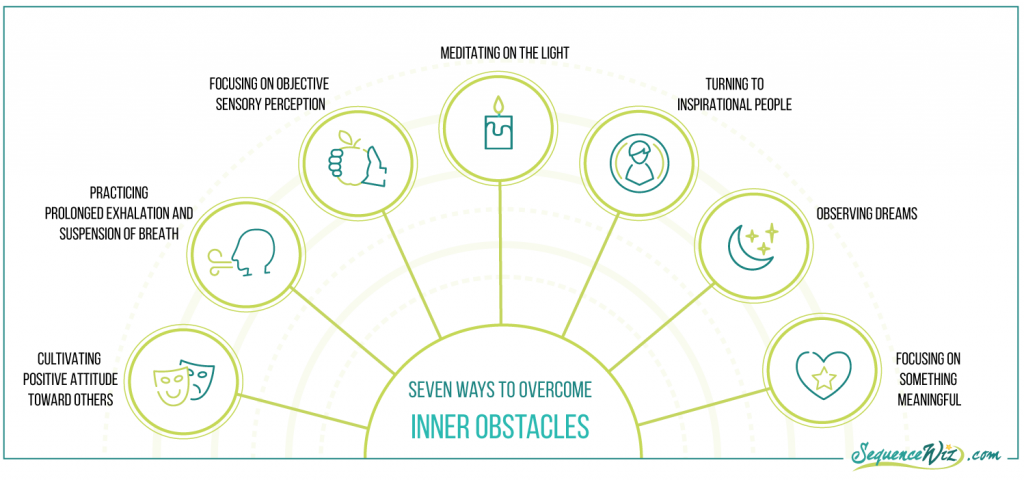How to overcome mental obstacles (part 2)
6I met my teacher Gary Kraftsow at an event called “Yoga and Meditation Conference” in Seattle in 2004. Even then I was slightly puzzled by the title of the event – it made it sound as if yoga and meditation were two separate things. In reality, meditation is a huge (if not the main) part of yoga and shares specific meditation techniques with many other spiritual traditions. This became even more clear once I began to study Patanjali’s Yoga Sutras, which barely mention asana and state that the most reliable way to overcome any mental obstacles is one-pointed focus (aka meditation).
Last week we discussed the first three options for concentration: positive attitude toward others, prolonged exhalation and objective sensory perception. Here are the other four options.
4. Meditating on the light
Mental stability also stems from concentrating on the light within.
The image of light is central to many spiritual and philosophical traditions. It usually manifests in one of three images: a beam of light, fire or sun.
- The image of a beam of light or any kind of glow is usually used in meditations to communicate a message of “light that illuminates darkness”. Moving from darkness to light symbolizes moving from ignorance to knowledge, from worldly desires to spirituality, from resistance to acceptance, or simply toward a better understanding of some pressing issue.
- The image of fire is used to both illuminate and invoke transformation potential. It also has purification quality. This image is used widely while working with Manipura (navel) chakra, since it is represented by the fire element and relates to processing and transformation (on the levels of physiological and mental digestion). It can also be used to work with other chakras, since you can envision the fire starting in your belly and then raising up high, illuminating and purifying the heart, speech and third eye center. The image of fire is also traditionally used in bandha work for the purpose of eliminating impurities and evaporating “the nectar of life” to replenish “the lake of the mind”.
- The image of the sun is often used as illuminating and life-giving. All living beings on the face of the earth get their life force from the sun. In the Hindu tradition, the sun is considered a “life giver” to the entire universe. It also has a meaning of selfless giving. Hafiz puts it beautifully in his poem Sunbeams:“Even after all this time the sun never says to the earth “you owe me.”
Look what happens with love like that – it lights up the whole world.”Surya Namaskar (both the mantra and the sequence of poses) is another obvious example of paying tribute to the sun and its life-giving power. It also invites you to internalize the image of the sun to bring inner light and clarity to your life, as well as encourage selfless service.
Either one of those light images encourages us to look within, to illuminate our inner challenges and transform our struggles into stepping stones to a more enlightened way of living.
5. Turning to inspirational people
Turning to a being whose mind is released from passions toward sensory objects is also calming.
In our modern society it is possible to become famous for all sorts of worthy and unworthy reasons and inspire a movement of followers. This yoga sutra encourages us to find inspiration from people who relinquished their grip on the sensory objects, including money, power, fame and so on. Instead it asks us to draw inspiration from people who follow more meaningful pursuits, such as their own spiritual journey or making the world a better place for all. It warns us against latching onto false idols and encourages us to seek inspiration from people who do the work or live the kind of life that has integrity and purpose.
6. Observing dreams
Mental stability also stems from witnessing dreams and deep sleep states.
The key word in this sutra is “witnessing” or “observation” – it encourages us to observe the flow of dreams and dream content rather then analyze or interpret it. When we are asleep the mind combines and recombines different memories, experiences and perceptions, sometimes coming up with rather unexpected stories. It is possible that this sorting and recombining process helps us create some distance from our recurring issues and get some unexpected insights. T.K.V.Desikachar puts it this way: “Inquiry into dreams and sleep and our experiences during or around these states can help us clarify some of our problems.”(1)
And if none of those objects of concentration speak to you, you are welcome to pick your own.
7. Focusing on something that’s meaningful to you
Choosing meditation according to one’s affinities brings mental stability.
It can be anything you want – an object, a person, an idea, a deity, a piece of nature; anything at all. Just be sure that the object of your meditation is inspiring and uplifting to you. Research shows that intentionally and consistently focusing on the positive aspects of the experience helps to rewire your brain from its evolutionary “glass-half-empty” tendencies to “glass-half-full” way of looking at things. “Whatever we repeatedly sense and feel and want and think is slowly but surely sculpting our neural structure. […] Mental states become mental traits. Day after day, your mind is building your brain.”(2) So if you want to be a present, alert, inspired and mentally stable human being, spend your time focusing on things that cultivate those qualities.
 So there you have it. According to the sutras, to overcome your inner roadblocks you need to pick one thing to focus on and stick with it for a while. You can focus on positive attitudes toward other people, prolonged exhalation, objective sensory perception, inner light, inspirational people, dreams or just pick something unique that you find meaningful. If you do that, the sutras continue, “Then the mastery of your mind will extend from the infinitely small to the infinitely large.” Sounds promising, doesn’t it?
So there you have it. According to the sutras, to overcome your inner roadblocks you need to pick one thing to focus on and stick with it for a while. You can focus on positive attitudes toward other people, prolonged exhalation, objective sensory perception, inner light, inspirational people, dreams or just pick something unique that you find meaningful. If you do that, the sutras continue, “Then the mastery of your mind will extend from the infinitely small to the infinitely large.” Sounds promising, doesn’t it?
Sequence Wiz members can download a PDF handout Seven ways to overcome inner obstacles with actual yoga sutras. It is located under Forms and Handouts.
Learn more about Sequence Wiz membership >
 Resources
Resources
- T.K.V. Desikachar The Heart of yoga: Developing a Personal Practice
- Rick Hanson Hardwiring Happiness: The New Brain Science of Contentment, Calm, and Confidence





















Thank you, Olga. I really appreciate your straightforward and insightful posts of the last two weeks. They are very illuminating and helpful to me.
That is great to hear Mindy! Thank you.
Thank you, Olga, I will cite you and some of your points to my students! I like the perspective you give on your articles!
Thank you Cindy! I am happy to hear that you will be passing this on to your students! I love it when people are interested in deeper meanings of their yoga practice.
Thank you, Olga. I really appreciate your straightforward and insightful posts. Yours Yoga Practise are very illuminating and helpful to me. Débora, From Argentina.
Thank you Débora! So happy to hear that my teachings had reached you in Argentina!